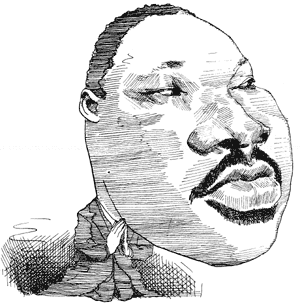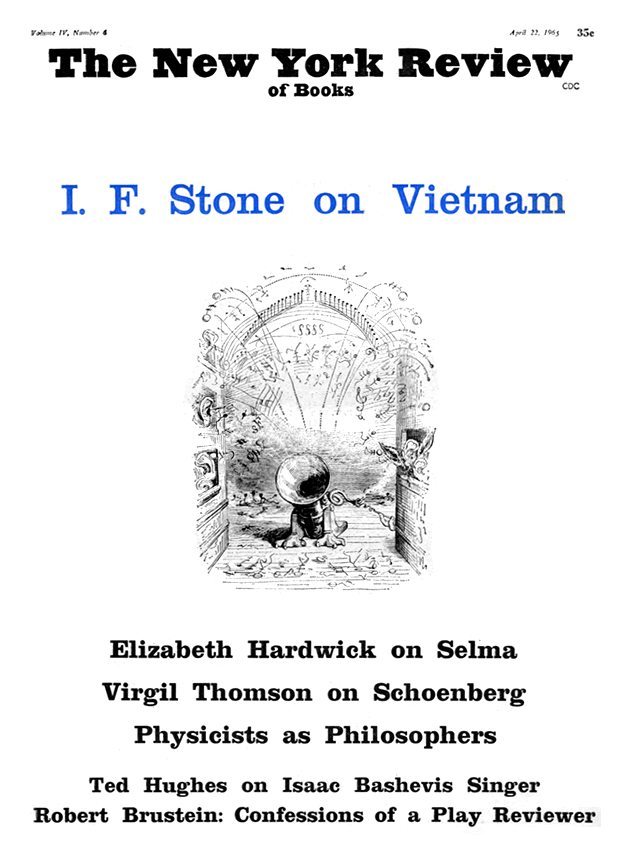Selma, Ala., March 22
What a sad countryside it is, the home of the pain of the Confederacy, the birthplace of the White Citizens Council. The khaki-colored earth, the tense, threatening air, the vanquished feeding on their permanent Civil War—all of it brings to mind flamboyant images from Faulkner. Immemorial, doomed streets, policed by the Snopeses and Peter Grimms, alleys worn thin in the sleepless pursuit of a thousand Joe Christmases, and Miss Coldfield and Quentin behind the dusty lattices, in the “empty hall echoing with sonorous, defeated names.” As you pass Big Swamp Creek, you imagine you hear the yelp of movie bloodhounds. The cabins, pitifully beautiful, set back from the road, with a trail of wood smoke fringing the sky, the melancholy frogs unmindful of the highway and the cars slipping by, the tufts of moss, like piles of housedust, that hang trembling from the bare winter trees, the road that leads at last to just the dead Sunday afternoon Main Streets you knew were there. We’ve read it all, over and over. We’ve seen it in the movies, in the Farm Administration photographs of almost thirty years ago: the voteless blacks, waiting tentatively on the court-house steps, the angry jowls of the racists, the washed-out children, the enduring Negroes, the police, the same old sheriff: the whole region is fiction, art, dated, something out of a secondhand bookstore. And this, to be sure, is the “Southern way of life,” these dated old photographs of a shack lying under a brilliant sky, the blackest of faces, the impacted dirt of the bus station, the little run-down churches, set in the mud, leaning a bit; and the big ones with yellow brick turrets and fat belfries. If this is not it, what else can they mean? The rest might be anywhere, everywhere—mobile homes, dead cars in the yards, little cottages and ranch houses shading their eyes with plastic awnings.
Life arranges itself for you here in the most “conventional” tableaux. Juxtapositions and paradoxes fit only for the most superficial art present themselves over and over. At their best the people who rule Selma, Alabama suffer from a preternatural foolishness and at their worst from a schizophrenic meanness. Just as they use the Confederate flag, so they use themselves in the old pageantry. The tableau (it might have been thought up decades ago by one of the Hollywood Ten): the early morning fog is lifting and a little band of demonstrators stand at their post at the end of the dusty street. A State Highway truck comes up and lets out three desolate Negro convicts wearing black and white striped convict uniforms. The convicts take up their brooms and, with their heads down, jailhouse and penitentiary hopelessness clinging to them, they begin their morose sweeping, up and up to the very shoelaces of demonstrators, the hem of a nun’s black skirts. On the heads of the convicts the soft melodies fall: we will overcome, or else go home to our Lord and be free. Great, great! we all say as the convicts and the demonstrators stand as if performing for us. Then off the convicts shuffle, wearing their black and white trousers, part of Alabama’s humble devotion to symbolism.
How do they see themselves, we wonder, these posse-men, Sheriff Clark’s volunteers, with their guns and sticks and helmets, nearly always squat, fairfaced, middle-aged delinquents and psychopaths? The State Troopers seem one ghostly step ahead of them on the social ladder. They ride around in their cars, their coats hanging primly in the back; they might be salesmen, covering their territory, on to the evening’s motel. Who will open the door of the University of Alabama or Clemson or Tulane to the sons of Klansmen? The posse-men live in a joyless night, with no culture or consolation except whiskey. The ignoble posture one observes so frequently in them puzzles. They are strangers to beauty and grace and are indeed the saddest looking people to be seen anywhere in the world. Even the hungry, bone-thin poor of Recife do not present such a picture of deep, almost hereditary, depression. These Southerners have only the nothingness of racist ideas, the burning incoherence, and that is all. No sacred text or hymn book or Armageddon in which all the black devils of the earth are to be swallowed up in some final quicksand of white eternity. Only violence can fill a hole so deep; this bereft, static existence which seems to go back so many generations has its counterpart in the violent, deranged hopelessness of the deprived youth in the cities.
A poor young man, a native of Alabama, in a hot, cheap black suit, and the most insistent of false teeth clinging to gums not over twenty-one years old, back-country accent, pale with that furry whiteness of a caterpillar, rimless glasses, stiff shoes, all misery and weakness and character armor, said to me, “When I saw those white folks mixed in with the colored it made me right sick!” And what could one say in this deprived land: Go see the social worker, find an agency that can help you, some family counsellor, or an out-patient clinic? I did say, softly, “Pull yourself together.” And he, too, like the convicts, shuffled off, shaking his head in some primordial perturbation of spirit.
Advertisement
So many of these white people are lost to history, waiting for the light to shine on them, waiting for some release from darkness. Who cares about their destroyed children? What charity can lift them up? When will the students come into the racist home and sleep on the floor and comfort these miserable people? You have to remind yourself that in the madness of the South these outcasts rule. They carry guns and whips and have power over senators and governors. They tell whoever it is that buys the books in the window in Montgomery (Herzog, Les Mots) and subscribes to The New Republic what they can do and cannot do. They keep in line those Southern queers who are “mad about Negroes” and who collect jazz records. And yet they are a degraded and despised people. This is another of the unbalancing paradoxes we expected to find, as it was, ready at hand.
The intellectual life in New York and the radical life of the Thirties are the worst possible preparation for Alabama at this stage of the Civil Rights movement. In truth it must be said that the demonstrations are an embarrassment of love and brotherhood and hymns and prayers offered up in Jesus’ name and evening services after that. Intellectual pride is out of place, theory is simple and practical, action is exuberant and communal, the battle-field is out-of-doors and demands of one a certain youthful athleticism that would, in a morning’s work, rip the veins of the old Stalinists and Trotskyites. The political genius of the Reverend Martin Luther King is, by any theory, quite unexpected. The nature of his protest, the quality and extent of his success sprang from a soil of religion and practicality most thinkers had thought to be barren. Looking back, it is curious to remember how small a part the Negro’s existence played in the left-wing movements. The concentration on labor problems, the Soviet Union, and the Nazis left the Negro as only a footnote to be acknowledged sometime by the unions or a welfare state. That it could have come to this was unthinkable: this cloud of witnesses, this confrontation between good and evil. Martyred clergymen, Negro children killed at their prayers, the ideas of Gandhi imposed upon restless Negroes and belligerent whites—these appear as some sort of mutation of a national strain. “God will take care of you,” they sing, Billy Eckstine style.
In the demonstrations and marches in Alabama you are watching—good people. The foundation is the Civil Rights Movement built by Southern Negroes and into this plot, like so many extras, these fantastic white people have come. On that “hallowed spot,” Sylvan Street, you feel you are witness to a new Appomattox played out with the help of overly-refined somewhat feminine Yankee clerics, upright people, marching in their prudent overshoes, some of them wearing coats with velvet collars. The deputy sheriff spoke of these “so-called ministers,” but that is a joke. Even a deputy can see that these are preacher faces. On a Sunday after the white churches had turned away the groups of “mixed worshippers” who had knocked at the doors, a Church of Christ found a verse in the Gospel of Matthew that seemed to explain what they had done in the morning. The verse was put up outside the church, in the announcement box, and it said, “When you pray, be not as hypocrites are, standing in the street.” But of course hypocrisy is as foreign to these people as vice and that, perhaps, is their story. There is no doubt that they have been, before this chance to be a witness, suffering from some frustration, aching with the shame of the Christian who is busy most of the time ridding the church of the doctrine of the past as he waits for some meaning in the present. The moral justice of the Civil Rights movement, the responsible program of the leaders, the tragic murderous rage of the white people: this was the occasion at last. For the late-comers perhaps the immediate instrument had to be the death of a young white idealistic Protestant minister.
In Alabama the cause is right, the need is great, but there is more to it than that. There is the positive attraction between the people. The racists, with their fear of touch, their savage superstition, their strange reading of portents, see before them something more than voting rights. They sense the elation, the unexpected release. Few of us have shared any life as closely as those “on location” in the Civil Rights movement. Shared beds and sofas, hands caressing the shoulders of little children, smiles and this spreading closeness, absorption: this is, as the pilgrims say over and over, a great experience. The police, protected by their helmets, are frightened by these seizures of happiness. The odd thing is that it should not be beatniks and hipsters and bohemians who are sending out the message, but good, clean, downright folk in glasses and wearing tie clasps.
Advertisement
This Issue
April 22, 1965



